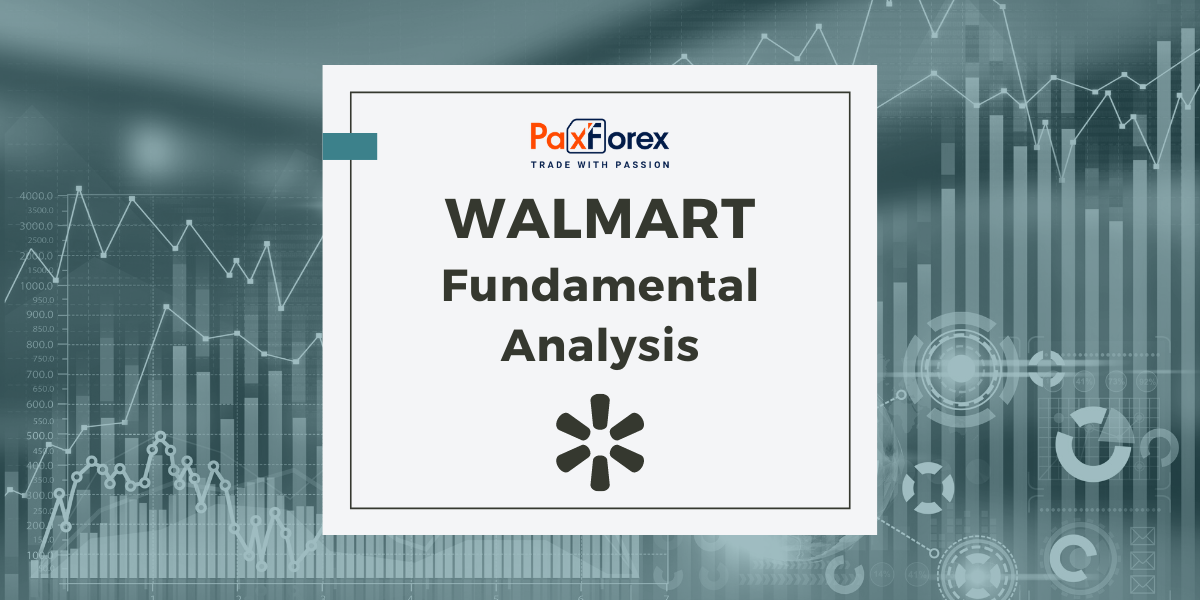
Source: PaxForex Premium Analytics Portal, Fundamental Insight
Even though the whole world is facing serious macroeconomic and geopolitical problems, especially high inflation and rising interest rates, some things never change. For instance, people buying groceries at Walmart is one of those things.
The stock price of the world's largest retailer by revenue is down 13 percent from its all-time high last April. Is now a suitable time to buy stock in hopes of a rebound? Or is it better to hold back?
In the fiscal year 2022 (which ended Jan. 31), Walmart had revenues of $611 billion, up 6.7% from the previous year. Same-store sales in the U.S., also known as comps, increased by 6.6%. E-commerce revenue in the U.S. was up 12%, and Sam's Club warehouse brand sales were also up double-digit percentages.
Although Walmart's revenues grew at a strong pace on an already huge base, macroeconomic factors put pressure on its margins. Gross margins fell from 25.1 percent in the fiscal year 2021 to 24.1 percent in the fiscal year 2022. The same story happened with operating margins, which dropped from 4.5% to 3.3%. Rising commodity costs and increased supply chain costs are to blame.
"In periods of inflation like this one, middle-income families, lower-middle-income families, and even wealthier families become more price sensitive," CEO said during the Q4 2022 earnings report. Because of its price structure, Walmart should still be in a good position to perform well." In the fiscal year 2023, management expects the company's revenues to grow by 2.5-3%, more in line with its historical performance.
In today's economic and market environment, there are several good reasons for investors to consider acquiring Walmart. For starters, it is a stable, predictable, and long-lived company that has been around for more than 60 years. The company's sheer size allows it to continue to offer low prices, and great deals will never go out of style, especially in an economic downturn.
What's more, Walmart is a consistently profitable enterprise, generating $11.7 billion in net income last fiscal year. Thus, there is absolutely no risk of insolvency for the company. At a time when investors favor solid assets over speculative growth stocks, Walmart's bottom line looks attractive.
The company's positive net income has allowed it to return excess cash to shareholders in the form of dividends. Impressively, Walmart has been paying dividends since 1974, and each year those payments have increased. And since only 30% of operating income went to dividends in the fiscal year 2022, management has enough flexibility to keep increasing the payout.
On the other hand, skeptical investors may find several reasons to refrain from buying the stock. While Walmart's huge scale is a competitive advantage, its disadvantage is that the company has limited reinvestment opportunities. Over the past 10 years, its sales have grown at an average annual rate of 2.7 percent -- in line with U.S. GDP growth. The company does not seem to have more room for expansion to outpace the economy.
In addition, Walmart's stock price has risen only 93% over the past decade, well below the S&P 500's 152% growth rate. The company's inability to outperform the market at a time when asset prices were experiencing one of their best periods due to quantitative easing means no good for its future earnings potential.
The final argument for Walmart is its current valuation. The company's stock trades at a trailing price-to-earnings ratio of 33, which is more expensive than the broader market. And at a projected price-to-earnings ratio of 23, Walmart stock also trades at a premium compared to competitors such as Target. This discrepancy doesn't seem justified, given that Target has grown its earnings faster than Walmart over the past 10 years and had higher average margins.
While there is no doubt that Walmart stock can be a good portfolio backbone and provide investors with a steady stream of income, it is unlikely to generate significant returns in the coming years. As a result, even though the stock is down 13% from its highs, it is probably better to stay away from Walmart now.
As long as the price is above 139.00, follow the recommendations below:
- Time frame: D1
- Recommendation: long position
- Entry point: 140.23
- Take Profit 1: 144.00
- Take Profit 2: 148.00
Alternative scenario:
If the level of 139.00 is broken-down, follow the recommendations below:
- Time frame: D1
- Recommendation: short position
- Entry point: 139.00
- Take Profit 1: 136.00
- Take Profit 2: 133.00













